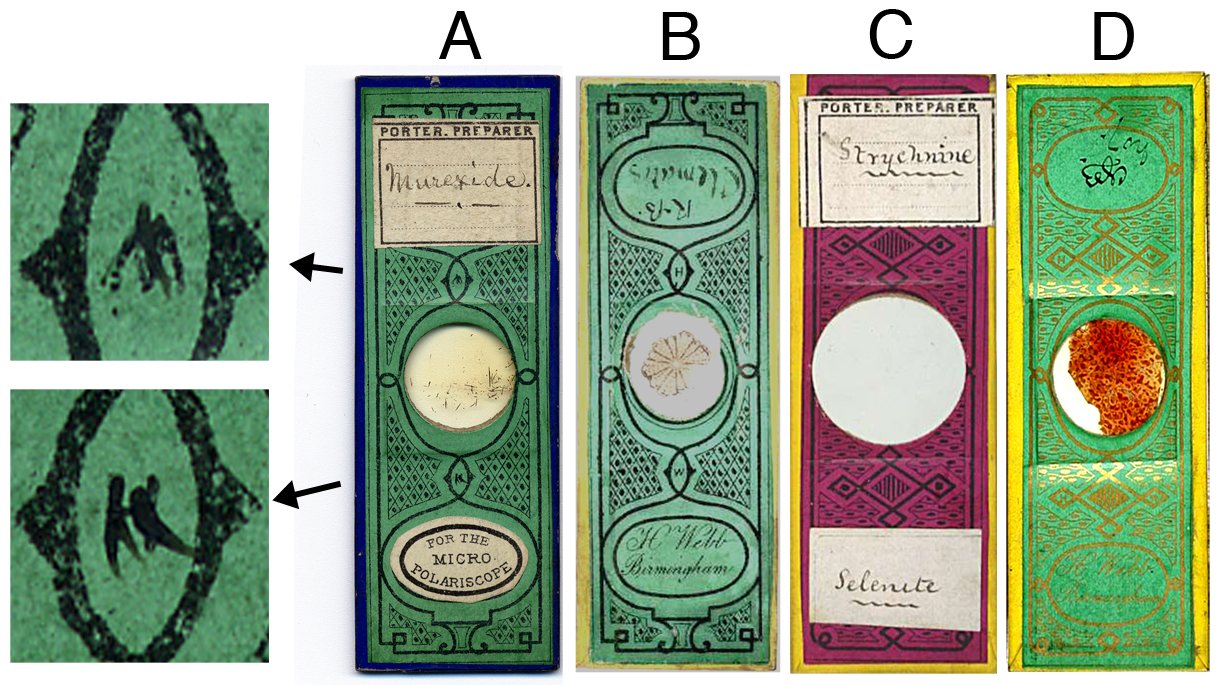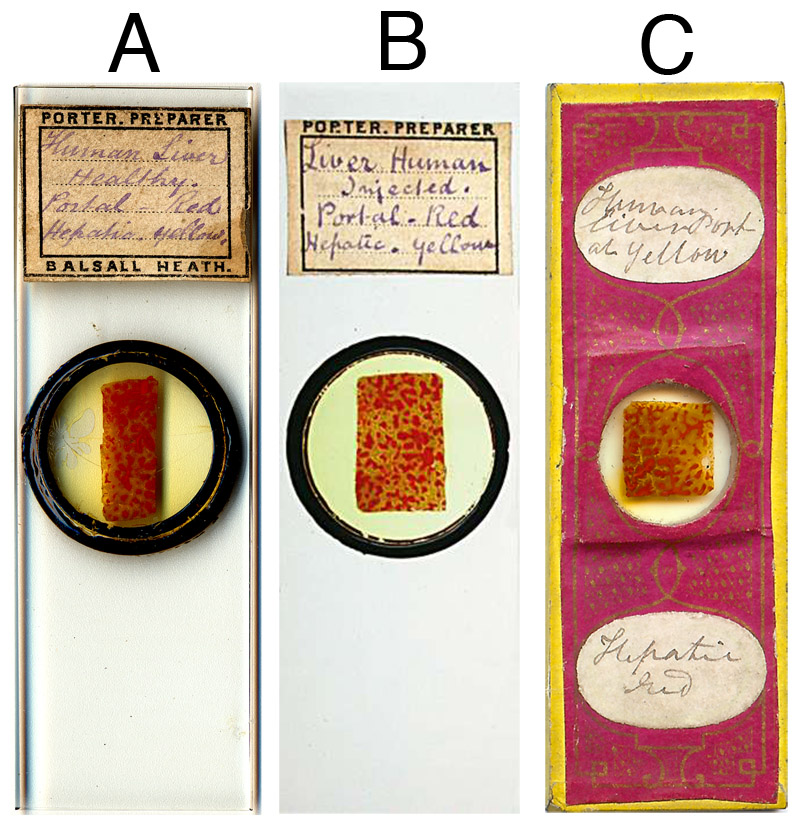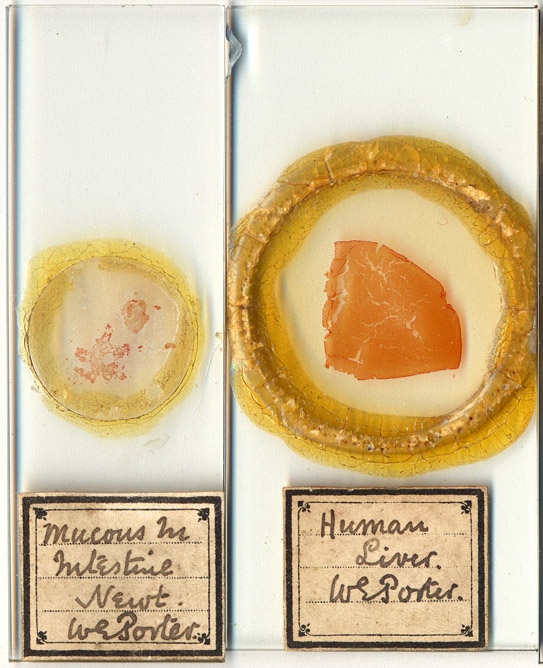William E. Porter, 1832 – 1909
by Brian Stevenson
last updated November, 2011
William Edward Porter was a chemist (pharmacist) by trade, who also produced and sold a fair
number of microscope slides during the 1860s-1870s. Brian Bracegirdle, in Microscopical
Mounts and Mounters, commented that Porter’s mounts tend to be chemical in
nature, a likely consequence of Porter’s main occupation. Three Porter slides are illustrated in
that book: 30-G, 30-H and 52-S. However, one error in Bracegirdle’s excellent reference was the
misidentification of the cover paper used in Porter slide 30-G as being that of
J.T. Norman, with a suggestion that Porter did not produce the mounts he
sold.Microscopical Mounts and Mounters slide 30-G actually has papers
that were originally printed for Henry Webb, not Norman. A similar Porter slide is shown below
in Figure 1A, alongside a Webb slide that used the same patterned paper (Fig.
1B). Note that Henry Webb’s paper
includes the lithographed initials “H” and “W” above and below the
specimen. Someone, presumably
William Porter, crossed out those initials on the Porter slide. Slide 30-G in Microscopical Mounts and Mounters contains similar markings. Figure 1C and D illustrate another pair
of Porter and Webb slides, using a different pattern of Webb’s paper. The Porter slide in Fig. 1C again has
the “H” and “W” initials blacked out. It is not certain whether Porter made these slides, or applied his own
labels to slides made by Webb. However, William Porter’s use of the term “preparer” to describe
himself, and the tendency of his slides to contain chemical specimens, suggests
that Porter actually did produce the microscope slides bearing his name.

Figure 1. Representative papered slides by William Edward Porter, and
comparisons with Henry Webb slides.
(A) A mount of the chemical
murexide, for viewing with polarized light. To the left are enlargements of the crossed-out lithographed
letters “H” and “W”, contained within the ovals above and below the
specimen. The absence of Porter’s
Balsall Heath address indicates that this slide was sold after 1871
(B)
The same type of paper as A, on a slide by Henry Webb.
(C)
A Porter mount of the chemical strychnine, using a different type of Webb’s
papering. The lithographed “H” and
“W” initials within diamond patterns have been covered over with dots of black
ink. As with slide A, Porter’s
removal of the Balsall Heath address indicates a sale date post-1871.
(D)
The same type of paper as in C, as used by Webb.

Figure 2. (A) An unpapered mount by
Porter, of “human liver, healthy”, with the portal vein stained red and the
hepatic vein yellow. The Balsall
Heath address indicates that this slide was sold at some time between 1866 and
1874.
(B) The same subject as B, and probably the from the same prepared
tissue, with the Balsall Heath address removed from the label, indicating a
sale date after 1871.
(C) A papered
slide prepared by Henry Webb containing what is probably the same injected human
liver tissue as in Porter slides A and B. These slides suggest that Porter obtained both specimens and papers
from Webb or (more likely) Webb’s widow.

Figure 3. Two histology slides signed by W. E. Porter. The handwriting very strongly resembles that of slide maker William E. Porter (compare with the Porter slides illustrated in Figures 1 and 2). When Porter made these slides, without his printed lables, is a mystery.
For less than a year, William Porter and Henry Webb were neighbors in Balsall Heath, in the Kings Norton district on the outskirts of Birmingham. Porter lived on Mary Street, while Webb lived on the
adjacent George Street. The Porter family moved to Balsall Heath during or shortly after 1866, as son William was
born during early 1866 in Hackney, Middlesex, while the 1867 Post Office
directory of the Birmingham area listed Porter as a chemist on Mary St. Henry Webb committed suicide in December, 1866. A reasonable
explanation for Porter’s use of Webb’s papers is that he purchased Webb’s
supplies after the latter’s death. Porter’s mounts of injected human liver sections that are similar to
those mounted by Webb (Fig. 2) further support that hypothesis. It is also possible that the mounting
supplies made available by Webb’s death led to Edward Porter’s side-job as a
maker and seller of microscope slides.
Note that the
label on the slide shown in Figure 2A lists Porter’s address in Balsall Heath,
while those in Figures 1A, 1C and 2B had the address removed. This suggests that slides 1A, 1C and 2B
date from after Porter moved away from Balsall Heath. Two of the slides shown in Microscopical Mounts and Mounters have similarly shorn labels
(slides 30-G and 30-H). Porter’s
daughter Ada was born during the spring of 1871 in Balsall Heath, while
daughter Jessie was born in the spring of 1874 in St. Johns (a suburb of
Worcester). Thus, we can date the
slide shown in Fig. 2A as having been sold between 1866 and 1874, and the
slides in Fig. 1A, C and 2B as being from after 1871. It is intriguing that the known Porter slides which used
Webb’s paper all date from after Porter’s move away from Balsall Heath, which
occurred at least 4 ½ years after Henry Webb’s death. The Balsall Heath slide from Porter shown in Figure 2, on
the other hand, is without covering papers. These observations further support the conclusion that
William Porter actually did produce many of his slides.
William Edward
Porter was born during October, 1832, in Broadwas, Worcestershire, the eldest
child of William and Mary Porter. William the father was a land surveyor. By the time of the 1861 census, William the son was working
as an assistant in the Society of Apothecaries. He then lived with his younger brother, Robert, and family
in Dudley, Worcestershire.
During late
1864, William married Mary Davies in Droitwich, Worcestershire. The following two years evidently
involved some significant moves, since their son William was born in
Middlesex. By 1867, the Porter
family was living in Balsall Heath, Worcestershire.
Other than the
existence of microscope slides bearing his name, the only known record of
William Porter’s involvement in microscopy came from his time in Balsall
Heath. The March 1, 1868 issue of Hardwicke’s Science-Gossip bore the
following advertisement: “Ligamentum
nuchae Giraffe (mounted) for other good mounted objects. — W. E. Porter, Mary
Street, Balsall Heath, Birmingham.” That tissue is the strong ligament which runs from the skull along the
back of the neck, helping to hold the head erect. This was apparently a fascinating tissue for 19th
century microscopists. According
to Lionel Smith Beale: “The fibres of the
ligamentum nuchae of the giraffe are very large, and remarkable for exhibiting
at short intervals transverse markings, which were first noticed by Professor
Quekett. These markings are situated in the internal part of the fibre, and do
not usually extend quite to its outer surface. They probably depend on
contraction of the oldest part of the formed material taking place as it gets
dry and condensed after its formation is completed. Unfortunately, I have not
had an opportunity of obtaining a portion of fresh ligamentum nuchae of a
giraffe, so that my specimens are defective in not exhibiting the bioplasm of
this particular form of yellow elastic tissue”. Exactly how a chemist in Worcestershire obtained ligament
from a giraffe is not known. A
strong possibility is that Porter obtained it from Webb’s estate, as Henry Webb
was an internationally-known maker of microscope slides who exhibited in many major expositions, and undoubtedly had access to exotica. However, it should be noted that the
Science-Gossip advertisement was published more than one year after Webb’s
death.
As mentioned
above, the Porters had left Balsall Heath for Worcester by 1874. The 1879 “Year-Book of Pharmacy” lists
among its members W.E. Porter, of 17 Tybridge St., Worcester. The 1881 England census places our
William Porter at 16 Tybridge St., and being employed as an analytical chemist. The “Porter Preparer” slides that had
the “Balsall Heath” address removed were undoubtedly sold after his move away
from Balsall Heath. It is not
known how much longer William Porter continued making and selling microscope
slides.
William
Porter’s first wife, Mary, died between 1881 and 1891, possibly during
1885. He then re-married, to a
much younger woman who was also named Mary. In 1891, William and family were living “on their own means”
in Leigh, Worcestershire. The 1901
census found William and his wife living in Malvern Link, Worcestershire, with
William recorded as being a retired analytical chemist. Porter died during late 1909 in Upton
upon Severn, Worcestershire, at the age of 77.
Acknowledgments
My thanks to
Marie Canavan for sharing biographical information on William Porter and his family,
and Brian Davidson and Thomas Lentz for providing images.
Resources
Beale, Lionel Smith, 1872, Bioplasm,
page 116, J. and A. Churchill, London.
Bracegirdle, Brian, 1998, Microscopical
Mounts and Mounters, Quekett Microscopical Club, London.
England vital statistics, accessed through ancestry.co.uk
Hardwicke’s Science-Gossip, 1868, vol. 4, March 1, page 72
Post Office Directory of Birmingham, 1867, pages 72 and 247. Accessed through http://www.historicaldirectories.org/hd
Year-Book of Pharmacy, 1879, page 362
Year-Book of Pharmacy, 1885, page 351


